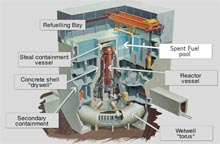Japan: Concern Power Sources ‘Compromised’ That Cool Spent Fuel Pools
The concern about the spent fuel pools at Fukushima Daiichi is that sources of power to cool the pools have been ‘compromised’, the IAES said.
Spent fuel removed from a nuclear reactor is highly radioactive and generates intense heat. This fuel needs to be actively cooled for one to three years in pools that cool the fuel, shield the radioactivity, and keep the fuel in the proper position to avoid fission reactions. If the cooling is lost, the water can boil and fuel rods can be exposed to the air, possibly leading to severe damage and a large release of radiation.
According to the IAEA, elevated radiation measurements at the site may be partially of the result of uncovered or overheated spent fuel.

The IAEA released Sunday a summary of spent fuel conditions at Fukushima Daiichi nuclear power plant, based on documents and confirmed by Japanese officials.
Unit 1
Unit 1 experienced an explosion on 12 March that destroyed the outer shell of the building’s upper floors. No precise information has been available on the status of the spent fuel pool.
Unit 2
No precise information has been available on the status of the spent fuel pool. Authorities began adding 40 tonnes of seawater to the spent fuel pool on 20 March.
Unit 3
Unit 3 experienced an explosion on 14 March that destroyed the outer shell of the building’s upper floors. The blast may have damaged the primary containment vessel and the spent fuel pool. Concerned by possible loss of water in the pool, authorities began spraying water into the building in an effort to replenish water levels. First, helicopters dropped seawater on 17 March, and every day since then, including today, emergency workers have sprayed water from fire trucks and other vehicles.
Unit 4
This reactor was shut down 30 November 2010 for routine maintenance, and all the fuel assemblies were transferred from the reactor to the spent fuel pool, before the 11 March earthquake. The heat load in this pool is therefore larger than the others.
On 14 March, the building’s upper floors were severely damaged, possibly causing a reduction of cooling capability in the spent fuel pool. Emergency workers began spraying water into the building today.
Unit 5 and 6
Instrumentation at these reactors began to indicate rising temperatures at their spent fuel pools starting on 14 March. Three days later, Japanese technicians successfully started an emergency diesel generator at Unit 6, which they used to provide power to basic cooling and fresh-water replenishment systems. Workers created holes in the rooftops of both buildings to prevent any hydrogen accumulation, which is suspected of causing earlier explosions at Units 1 and 3.
A second generator came online on 18 March, and the next day, the higher-capability Residual Heat Removal system recovered full function. Temperatures in the spent fuel pools of Units 5 and 6 have gradually returned to significantly lower temperatures.
Common Use Spent Fuel Pool
In addition to pools in each of the plant’s reactor buildings, there is another facility — the Common Use Spent Fuel Pool — where spent fuel is stored after cooling at least 18 months in the reactor buildings. This fuel is much cooler than the assemblies stored in the reactor buildings.
Japanese authorities have confirmed that fuel assemblies there are fully covered by water, and the temperature was 57 ˚C as of 20 March, 00:00 UTC.
